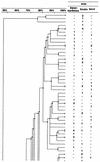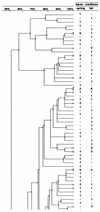Haemophilus influenzae carriage in children attending French day care centers: a molecular epidemiological study
- PMID: 12682158
- PMCID: PMC153885
- DOI: 10.1128/JCM.41.4.1664-1672.2003
Haemophilus influenzae carriage in children attending French day care centers: a molecular epidemiological study
Abstract
The nasopharyngeal Haemophilus influenzae flora of healthy children under the age of 3 years attending day care centers in three distinct French geographic areas was analyzed by sampling during two periods, spring 1999 (May and June) and fall 1999 (November and December). The average carrier rate among 1,683 children was 40.9%. The prevalence of capsulated H. influenzae carriers was 0.4% for type f and 0.6% for type e. No type b strains were found among these children, of whom 98.5% had received one or more doses of anti-Haemophilus b vaccine. Among the strains, 44.5% were TEM-type beta-lactamase producers and nine (1.3%) were beta-lactamase-negative ampicillin-resistant strains. Pulsed-field gel electrophoresis restriction patterns showed a large diversity with 366 SmaI patterns from 663 strains. Among the strains isolated during a given period, 33% were isolated simultaneously in more than one area. In each area, depending on the sampling period, 68 to 72% of the strains had new pulsotypes and persistence of 28 to 32% of the strains was noted. For the 297 beta-lactamase-producing strains, 194 patterns were found. The genomic diversity of these strains was comparable to that of the whole set of strains and does not suggest a clonal diffusion. Among the beta-lactamase-producing strains isolated in November and December, depending on the area, 66 to 73% had new pulsotypes with persistence of only 27 to 33% of the strains. In any given geographic area, colonization by H. influenzae appears to be a dynamic process involving a high degree of genomic heterogeneity among the noncapsulated colonizing strains.
Figures








Similar articles
-
Antibiotic susceptibility and genotypic characterization of Haemophilus influenzae strains isolated from nasopharyngeal specimens from children in day-care centers in eastern France.Clin Microbiol Infect. 2000 Oct;6(10):519-24. doi: 10.1046/j.1469-0691.2000.00151.x. Clin Microbiol Infect. 2000. PMID: 11168045
-
Nasopharyngeal Haemophilus influenzae carriage in Japanese children attending day-care centers.J Clin Microbiol. 2008 Mar;46(3):876-81. doi: 10.1128/JCM.01726-07. Epub 2008 Jan 9. J Clin Microbiol. 2008. PMID: 18184852 Free PMC article.
-
Low rate of nasopharyngeal carriage and high rate of ampicillin resistance for Haemophilus influenzae among healthy children younger than 5 years old in northern Taiwan.J Microbiol Immunol Infect. 2008 Feb;41(1):32-40. J Microbiol Immunol Infect. 2008. PMID: 18327424
-
Nasopharyngeal carriage of potential bacterial pathogens related to day care attendance, with special reference to the molecular epidemiology of Haemophilus influenzae.J Clin Microbiol. 2002 Aug;40(8):2832-6. doi: 10.1128/JCM.40.8.2832-2836.2002. J Clin Microbiol. 2002. PMID: 12149338 Free PMC article.
-
Genetic diversity of the ftsI gene in β-lactamase-nonproducing ampicillin-resistant and β-lactamase-producing amoxicillin-/clavulanic acid-resistant nasopharyngeal Haemophilus influenzae strains isolated from children in South Korea.Microb Drug Resist. 2013 Jun;19(3):224-30. doi: 10.1089/mdr.2012.0116. Epub 2013 Jan 11. Microb Drug Resist. 2013. PMID: 23308379
Cited by
-
Haemophilus influenzae Carriage among Healthy Children in Portugal, 2015-2019.Microorganisms. 2022 Oct 4;10(10):1964. doi: 10.3390/microorganisms10101964. Microorganisms. 2022. PMID: 36296240 Free PMC article.
-
Detection of Haemophilus influenzae type b by real-time PCR.J Clin Microbiol. 2004 Aug;42(8):3813-5. doi: 10.1128/JCM.42.8.3813-3815.2004. J Clin Microbiol. 2004. PMID: 15297536 Free PMC article.
-
Epidemiology and evolution of antibiotic resistance of Haemophilus influenzae in children 5 years of age or less in France, 2001-2008: a retrospective database analysis.Eur J Clin Microbiol Infect Dis. 2012 Oct;31(10):2745-53. doi: 10.1007/s10096-012-1623-9. Epub 2012 Apr 27. Eur J Clin Microbiol Infect Dis. 2012. PMID: 22538797
-
Pharyngeal colonization dynamics of Haemophilus influenzae and Haemophilus haemolyticus in healthy adult carriers.J Clin Microbiol. 2007 Oct;45(10):3207-17. doi: 10.1128/JCM.00492-07. Epub 2007 Aug 8. J Clin Microbiol. 2007. PMID: 17687018 Free PMC article.
-
Access to highly specialized growth substrates and production of epithelial immunomodulatory metabolites determine survival of Haemophilus influenzae in human airway epithelial cells.PLoS Pathog. 2022 Jan 27;18(1):e1010209. doi: 10.1371/journal.ppat.1010209. eCollection 2022 Jan. PLoS Pathog. 2022. PMID: 35085362 Free PMC article.
References
-
- Bernstein, J. M., D. Dryja, N. Yuskiw, and T. F. Murphy. 1997. Analysis of isolates recovered from multiple sites of the nasopharynx of children colonized by nontypeable Haemophilus influenzae. Eur. J. Clin. Microbiol. Infect. Dis. 16:750-753. - PubMed
-
- Bou, R., À. Domínguez, D. Fontanals, I. Sanfeliu, I. Pons, J. Renau, V. Pineda, E. Lobera, C. Latorre, M. Majó, L. Salleras, and the Working Group on invasive disease caused by Haemophilus influenzae. 2000. Prevalence of Haemophilus influenzae pharyngeal carriers in the school population of Catalonia. Eur. J. Epidemiol. 16:521-526. - PubMed
-
- Comité de l'Antibiogramme de la Société Française de Microbiologie. Communiqué 2002. [Online.] http://www.sfm.asso.fr/Sect4/com2002.pdf.
Publication types
MeSH terms
Substances
LinkOut - more resources
Full Text Sources
Medical
Molecular Biology Databases

